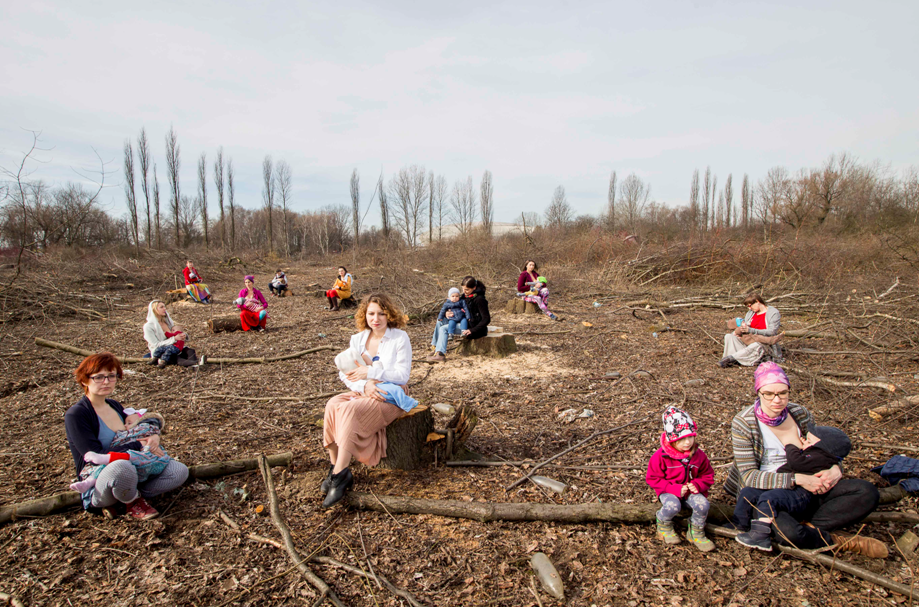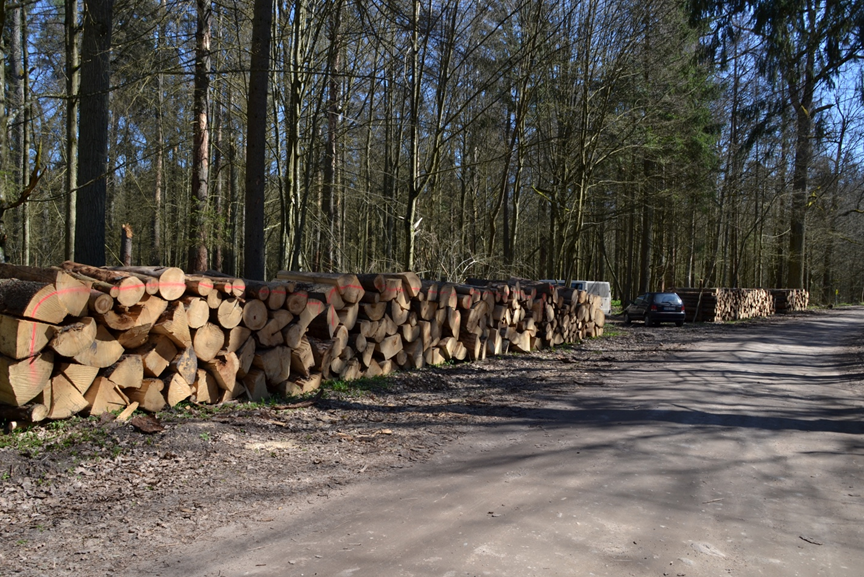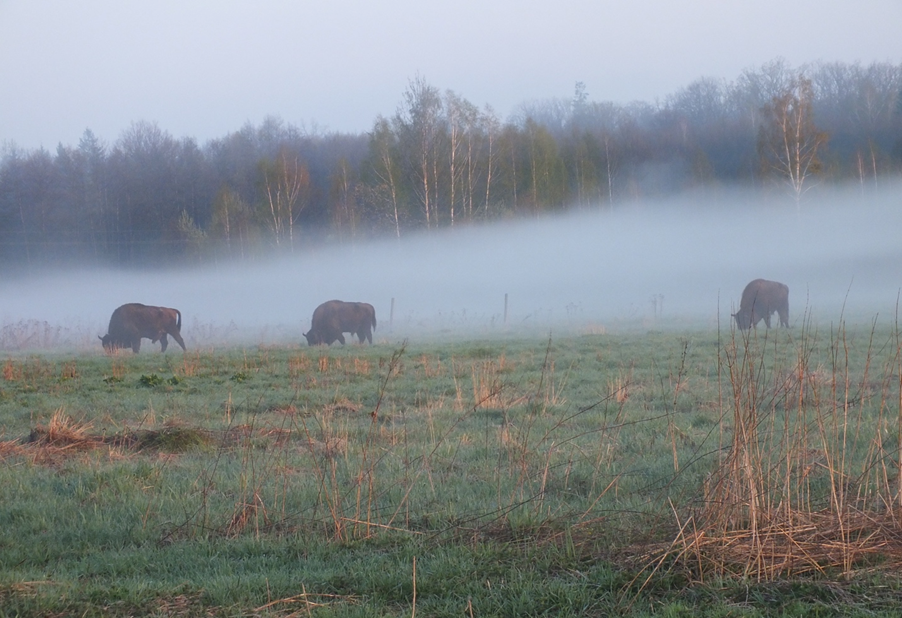- A bark beetle outbreak has led Polish officials to begin large-scale logging across old-growth Białowieża Forest, home to bison, wolves and a rich cultural history.
- The logging is opposed by everyone from scientists to the UN to the European Commission to a group of mothers concerned about the world their children will inherit.
- The European Commission has recently declared that all logging should cease.
In a recently logged clearing outside Krakow, Poland, a woman sits on a tree stump, nursing her child. She looks down affectionately, her purple knitted cap and magenta jacket vividly defined against the subdued brown hues of the surrounding arboreal graveyard. She is not alone. Several other women are dotted about the clearing, sitting on tree stumps of their own. Each mother holds a child in her arms. These are the women who speak for the trees.
Matki Polki na wyrębie or “Polish Mothers at the Felling” is a grassroots group of local mothers formed earlier this year to protest newly intensified logging practices that are slashing their way across the Eastern European country.

In March 2016, Polish environment minister Jan Szyszko green-lighted a three-fold logging increase in Białowieża, the largest of Europe’s last old-growth forests. This January, a logging amendment nicknamed “Szyszko’s Law” went into effect, allowing private landowners to cut down any tree on their property without giving permission or notice of any kind.
“[Forests are] part of our culture and our heritage, and our pride,” said Daria Gosek of Polish Mothers at the Felling. “Sadly instead of preserving them, foresters more and more often are pursuing profit and a wish to earn money from selling timber, and cutting them down.”
Logging now continues at breakneck speed, threatening to snuff out all but the 17 percent of Białowieża currently protected as a national park. Szyszko has shown no sign of slowing down, saying that “man has not only the right, but the duty, to use natural resources.”
The European Commission, the United Nations, and many Polish citizens, scientists, and NGOs disagree, at least in this case. Białowieża is a UNESCO World Heritage site, protected as a Natura 2000 site, and has been labeled as an Important Bird Area by BirdLife International. UNESCO describes the forest as “an irreplaceable area for biodiversity conservation, due in particular to its size, protection status, and substantially undisturbed nature.”

In the Spring of 2016, the non-profit environmental law organization ClientEarth lodged a formal complaint with the European Commission against the logging in Białowieża. The Commission found that Poland was in breach of the EU Birds and Habitats Directives, and gave the country one month to respond to a final warning this April.
On July 13, the Commissions deemed Poland’s response insufficient and recommended an immediate ban on logging in Białowieża, referring the case to the EU Court of Justice.
Local citizens and NGOs are turning up the heat as well. Throughout May and June, protestors from Greenpeace and Wild Poland have chained themselves to logging equipment. On June 7, the Polish Mothers at the Felling hand-delivered a report outlining their concerns to the Pope in Rome. On June 24, over 5,000 people marched against logging in Warsaw.
The forest is an invaluable site of biodiversity, ecosystem services and a living time capsule of Polish culture and tradition spanning hundreds of years. Time and again, through war, occupation, and hardship, the forest has emerged with its ancient ecosystem and essential identity intact. Białowieża’s iconic megafauna, the European bison (Bison bonasus), was brought back from the brink of extinction thanks to the animal’s unique connection to Polish nobility. Now, this more than 10,000-year-old forest is facing potentially its biggest threat yet.

Journey to the land of trees
European history is taught as a story of human development. A tale of power struggles settled with swords and gunpowder on the battlefield or waged in whispers behind castle walls. We learn of plagues and death, of scholars and enlightenment. We learn of formidable fortresses and expansive cathedrals, and of tentacles of power that creep out to the south, east, and west.
However, all these stories of expansion, discovery, and conflict do not exist in a vacuum. They have been set on a stage green with trees. While forests are never cast in leading roles, they have always been there. Europeans sailed their trees across the sea, used their branches to keep warm through harsh winters, and built cities full of wooden houses. Royal families developed elaborate hunting rituals under their canopies, and villagers gathered mushrooms, nuts, and berries to nourish their families. Many of the fairytales and myths we know today emerged from somewhere deep in the heart of a European forest.
Of course, as land changed hands and wars were fought, Europe’s carpet of forest has changed shape and form. No landscape has a truly static character, and Europe’s forests have gone through many transformations, both natural and man-made. The Middle Ages were particularly hard on forests, as many were converted to farmland. During World War I, pockets of forest were squeezed and wrung out, as desperate armies stripped the land for food and fuel.
Where fragments of forest remain, however, a woodland landscape can replenish over time. The trees might be smaller and more homogenous, the animals they shelter diminished, but they will recolonize the land given the chance.
One particular European forest, however, has not simply recolonized, but persisted and even flourished. The near-pristine interior of Poland’s Białowieża Forest, with towering 500-year-old trees, toppled trunks carpeted with mosses and lichens, and lurking lynx (Lynx lynx) and wolves (Canis lupus lupus) is like something out of a Brothers Grimm fairytale. It owes its near-magical state, in part, to Polish nobles, who fancied themselves as wild and untamable as the forest itself.
Białowieża: a fairytale land ruled by human hubris
There is a crisp chill in the air. It is autumn in Białowieża, and leaves crunch underfoot as a hunting party trudges forward, picking its way around fallen oaks and and soggy bogs. After a time, the trees give way. The party has reached its destination: a natural clearing at the heart of the wood, where an artfully designed hunting pavilion awaits. One thousand “beaters,” encircling the clearing, have already fanned out on all sides. They now move purposefully inwards, doing the work of spooking today’s targets out from amongst the tree trunks. Silence descends, and exhilarated breaths steam the air. Then, suddenly, a snorting, hump-backed beast lumbers into the clearing. There is a distinct crack. Maria Josepha, Queen of Poland, has just shot her first bison of the day.
Such a scene occurred on September 27, 1752, when King Augustus III and his queen visited Poland, and was a common one for this period of Polish history. In retreating to their wooden hunting lodge deep in the wild forest, Polish nobility could cast themselves as the fierce warriors of old.
The Polish love affair with bison, in particular, can be traced at least as far back as the 16th century. Writings from the time depicted the bison as a wild and ferocious beasts harking back to prehistoric times. The bison, and the dark and unruly forest it called home, were both feared and revered for their tenacity.
As time went on, and courtly manners and lavish dwellings became the norm in 18th century Europe, the forest and its mysterious denizens became a favorite retreat. In Western Europe, the royal hunt was increasingly regulated by a variety of rules and ornamental trimmings, using dogs specially bred for tracking or attack. In unruly Białowieża, however, each hunting party stuck to the basics: a gun, a hunting horn, and a pack of loyal hounds.
Because of Białowieża’s near-sacred quality and importance to these hunting rituals, the mythology of its untamable nature was a self-fulfilling prophecy. Many forests at the time were developed, but Białowieża remained as wild as ever – minus a substantial number of bison and elk.
Then, at the turn of the 19th century, foresters turned their gaze to the primeval woodland. Baron von Brincken was the man put in charge of the forest in the early 1800s, and though he had ambitious plans to turn it into a grand timber plantation, the writings he left behind betrayed his awe of the forest. He fell hardest, of course, for the bison. He showed his love like a scientist, by observing, counting, measuring, and dissecting them. He even tried to move a population out of the forest, but finally determined that only Białowieża’s unique ecology was suitable to the reclusive beast.

Somehow, with logging and development closing in on all sides, the very heart of Białowieża remained untouched through the 19th century. Then came World War I.
The global conflict was especially hard on Białowieża. The forest was stripped for parts, partitioned into firewood, building materials, and game; all romantic notions were crushed by desperation and scarcity. The European bison, the forest’s fierce protector, went extinct in the wild in 1921, after limping along for a few final years after the war. But Poland was proud of its bison, and had been gifting them to zoos for years. A biologist reintroduced the animals to Białowieża in 1929, and soon after, part of Białowieża was declared a national park. The forest had survived its first brush with total annihilation.

Białowieża’s second brush with annihilation
Today, about ten percent of the spruce trees in Białowieża Forest’s UNESCO world heritage site are infected with a bark beetle outbreak. Bark beetles are known throughout the world as a scourge on forests, eating their way through the bark of trees, laying their eggs, and leaving death and destruction in their wake.
Polish environment minister Jan Szyszko has claimed that those speaking out against the current three-fold logging increase in Białowieża don’t understand that it is necessary to save the forest from the beetles. Recently, Szyszko publicly declared that the forest’s UNESCO status was illegal and detrimental to forest management objectives. Another member of the Law and Justice Party, Jadwiga Wisniewska, has called Poland’s ecologists and environmental NGOs “false defenders, who would allow the forest to rot away before our eyes.”
However, only half of the trees being targeted for logging are spruce. And some scientists argue that bark beetles can actually be highly beneficial to forest ecosystems.
“The forest has continuously existed here for 11,800 years, and experienced tens or hundreds of bark beetle outbreaks,” said Rafal Kowalczyk, director of Poland’s Mammal Research Institute. In fact, an outbreak is “one of the natural processes that speed adaption of the forest to climate change.”
Diana Six, one of the world’s foremost bark beetle experts, agreed.

“I don’t know of any instances where logging has actually shut down an outbreak,” she said. “You have to get between 85-90 percent of the beetles to have any impact, and that turns out to be logistically impossible.”
One of the main issues in attempting to manage an outbreak is that bark beetles are a symptom of a wider problem. In the case of Białowieża, drought conditions have weakened the trees, lowering their natural defenses and giving the beetles an opportunity to move in.
“It is scary to me that people are suggesting that in order to protect a place like this [old growth forest] they have to go in and begin to manage [it],” Six said. “It doesn’t sound to me like the entire focus here is on trying to protect the forest.”
A European Commission fact-finding mission came to that precise conclusion before issuing their final warning. A Commission spokesperson stated that the Polish government’s new measures “exceed those necessary for ensuring the safe use of the forest and are not compatible with the conservation objectives.”
Over 40 percent of the logging is currently taking place within the Białowieża UNESCO World Heritage site, in which many animals, lichens, mosses, and fungi are dependent on dead and rotting wood for survival. The three-toed woodpecker (Picoides tridactylus) and white-backed woodpecker (Dendrocopos leucotos) can only live in old-growth forests with plenty of dead wood to nest in and bark beetles to eat. Predators rely on dead wood littering the forest floor to slow their prey, and bats rely on old trees for shelter.
“The forest is characterized by high biodiversity thanks to dead wood,” said Kowalcyzyk. “Logging dead spruce and taking them out will destroy habitat for many organisms…and take out millions of invertebrates.”

Along with bark beetles, Catholicism has played a major role in shaping the rhetoric around increasing forest management. Szyszko has advocated for management in accordance with what he sees as man’s God-given right, as stated in the Book of Genesis, to “fill the Earth and subdue it.”
At a conference co-hosted by the Ministry of Environment this May, Tadeusz Guz of the Catholic University of Lublin called environmentalism “atheistic, materialistic and nihilistic neo-communism” and compared environmentalists to Nazis.
This is why, in June, the Polish Mothers at the Felling traveled to Rome.
“We wanted to show that Catholicism is caring for nature, not chopping down trees – because [Pope] Francis wrote about this in his environmental encyclical,” sad Gosek. “We waited along with our children in St. Peter’s Square and the Pope drove up to us, blessed our children, and took the report.”
The Mothers are desperate to try anything that might save their country’s forests. “We are on the threshold of an environmental disaster,” said Gosek. “Polish towns are already among the most polluted in Europe, and we have a huge problem with smog. Trees are our most important allies.”
Today, primeval forests no longer stretch across the European continent, casting comforting shadows that hold the promise of food, shelter, fuel, and fresh, clean air. The few remaining are holed up, fenced in, driven back to small pockets of land. Here, they make a final stand. The same notion of human progress they made possible is now slashing and burning them out of existence. If these forests are destroyed, their memories and vast wealth of biodiversity and ecosystem benefits will vanish forever.
“The Białowieża Forest is the last European island of primevality, it is our great heritage and responsibility,” said Kowalczyk. “We have to protect it.”


References:
Schama, S. (1995). Landscape and Memory. New York, New York: Vintage Books.
Six, D. L., Biber, E., & Long, E. (2014). Management for mountain pine beetle outbreak suppression: Does relevant science support current policy? Forests, 5(1), 103-133.